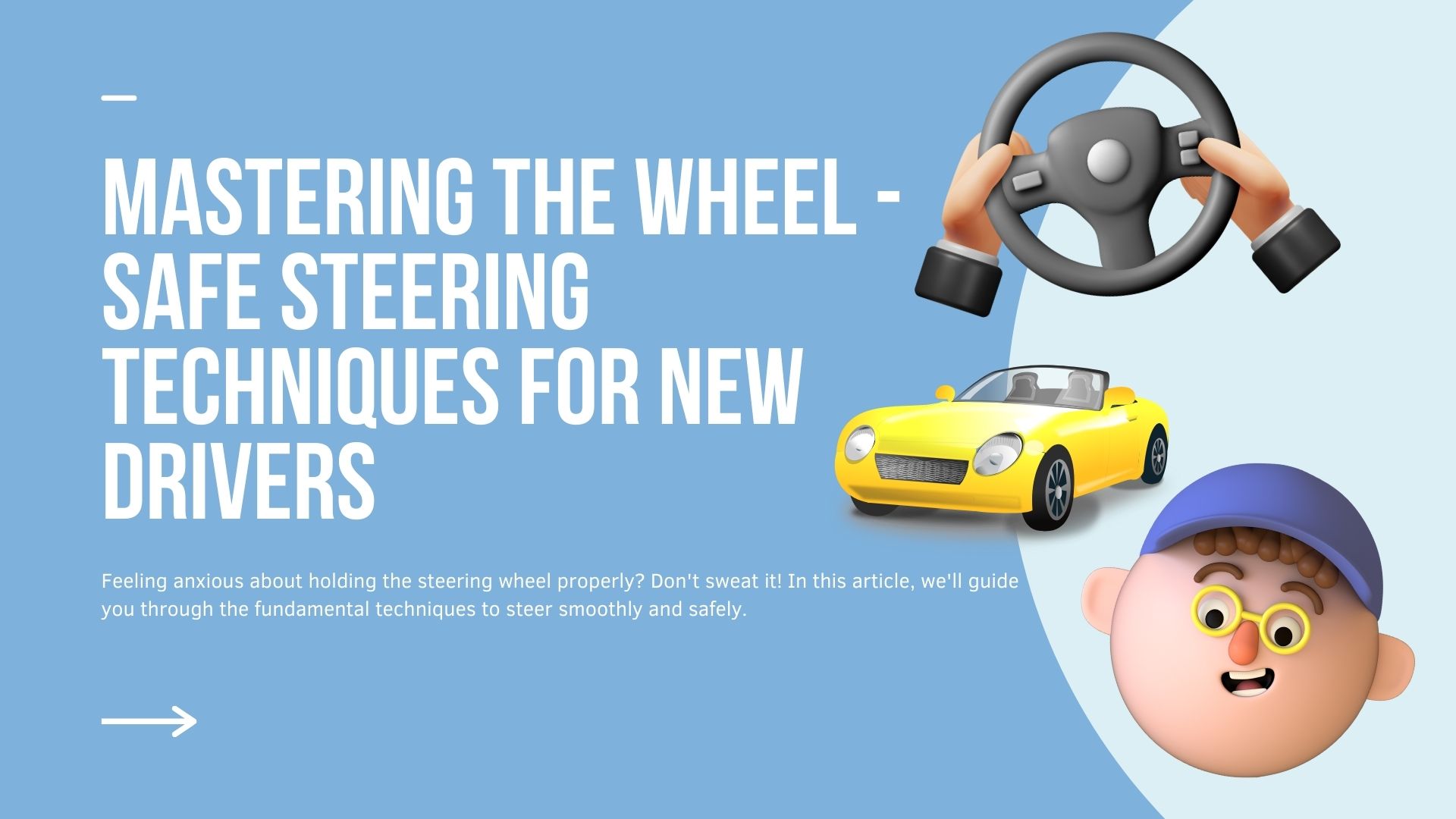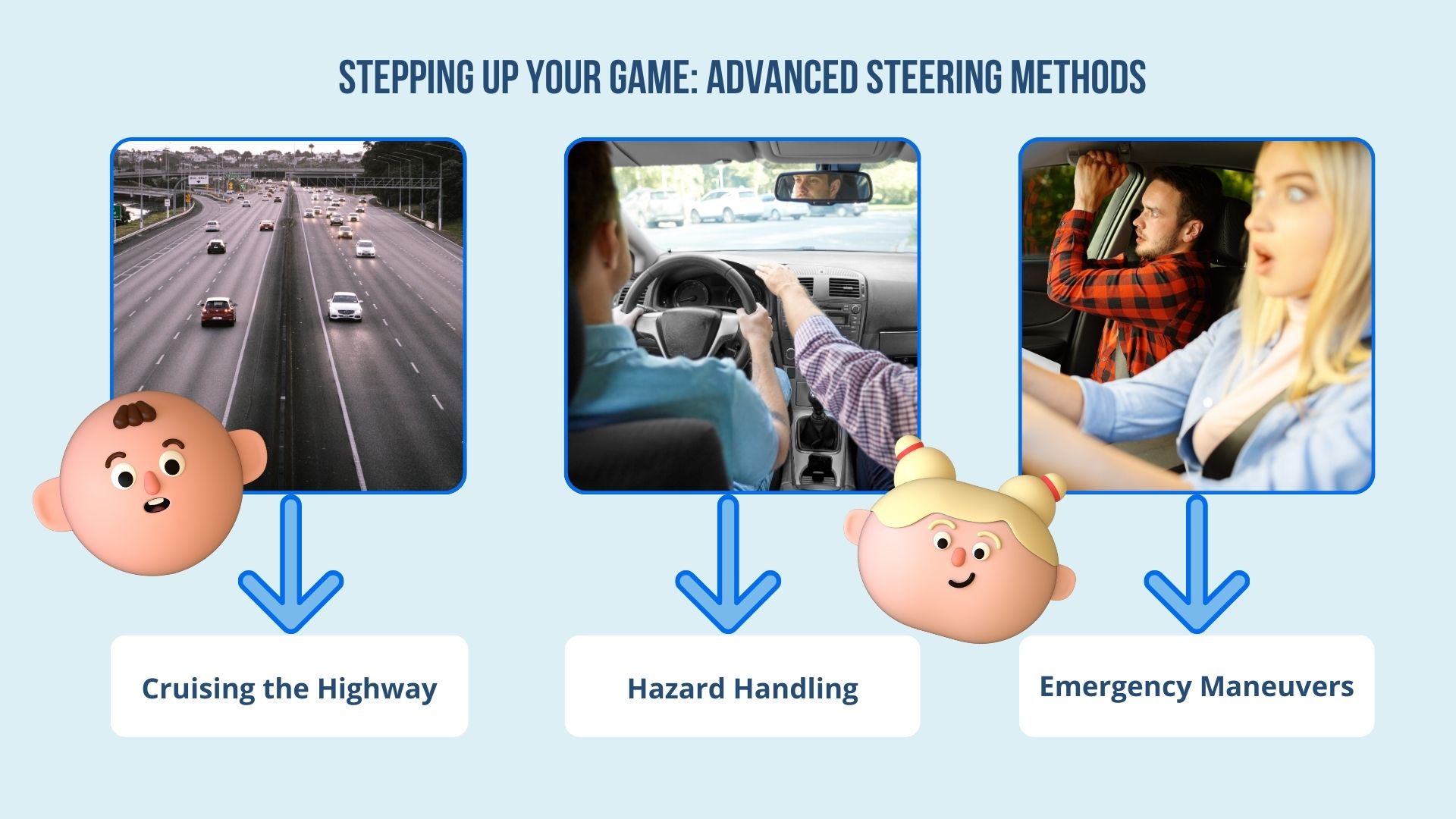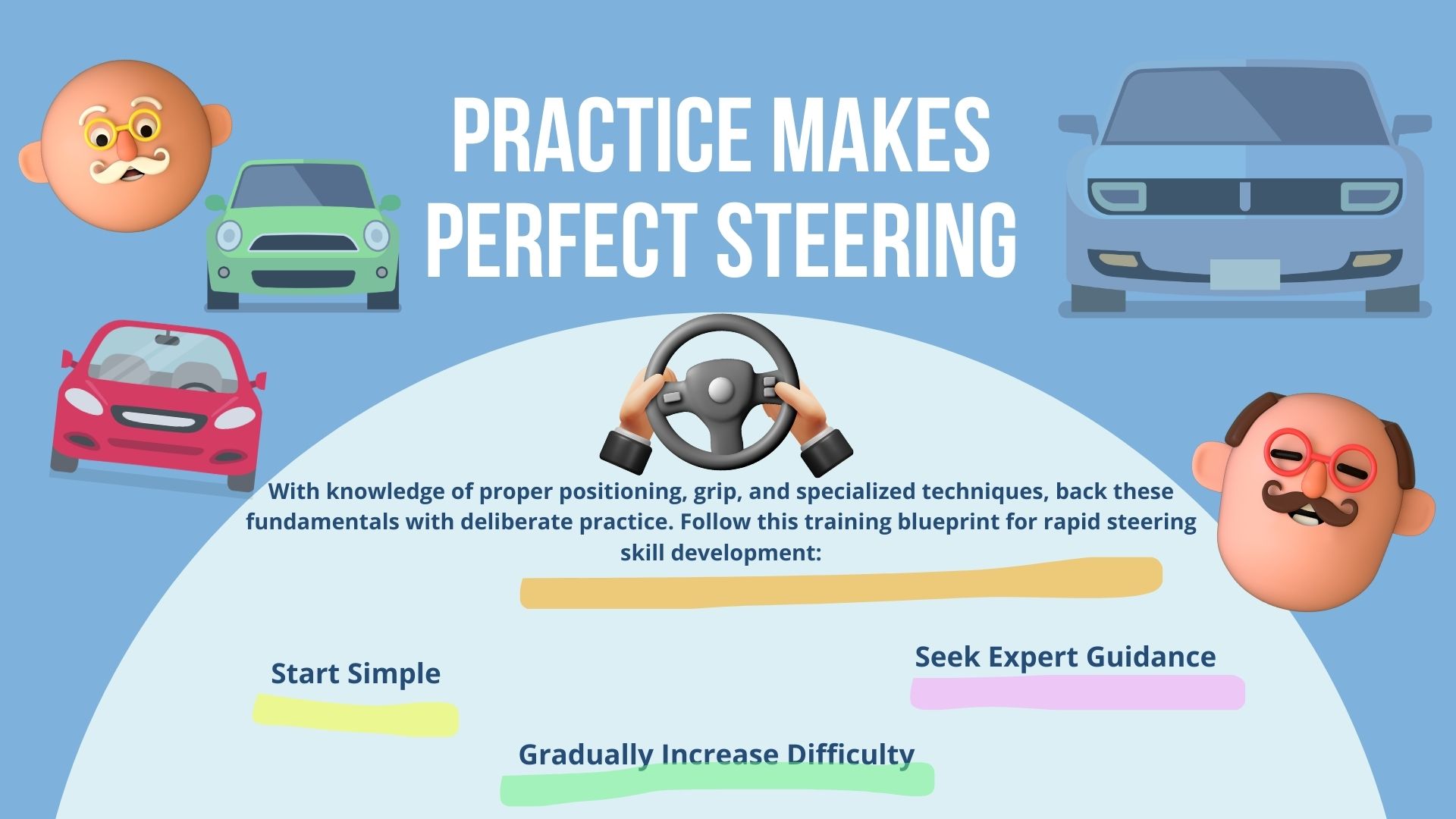Mastering the Wheel - Safe Steering Techniques for New Drivers

Table of Contents
Feeling anxious about holding the steering wheel properly? Don't sweat it! In this article, we'll guide you through the fundamental techniques to steer smoothly and safely.
The safest steering control method is the push/pull technique, also called hand-to-hand steering. By gripping the wheel with both hands and making controlled turning inputs, you can maintain complete control even in hazardous conditions.
We'll overview proper hand positioning adjustments for comfort, highlight maneuvering methods tailored to different driving scenarios, and provide tips to avoid common mistakes.
Here's what we'll cover:
- Steering Basics for Everyday Driving: Find your ideal seat height, test hand positions like 9-and-3 vs. 10-and-2, and learn how to hold the wheel firmly but gently.
- Techniques for Tricky Situations: Handle highways, sudden obstacles, and emergencies with specialized techniques like smooth lane changes and threshold braking.
- Correcting Common Errors: Mitigate dangerous habits like one-handed driving or poor posture through simple fixes.
- Practice Drills to Build Skill: Start in empty parking lots, then progress to quiet streets and busier roads with our tried-and-tested training blueprint.
By road testing the core principles here, you'll ingrain the muscle memory needed to steer precisely around any bends in the road ahead. Stick with us to accelerate your handling capabilities!
Steering Wheel Basics for Everyday Driving Comfort
Before trying advanced techniques, dial in your comfort and control with these fundamental adjustments.
Finding the Right Seat Fit
Your seat positioning impacts steering ease and safety. Follow this fitting sequence for optimal wheel access:
- Adjust the seat height so your line of sight clears the dashboard.
- Move the seat forward enough to fully depress the pedals without overextending.
- Recline slightly while keeping your back supported.
- Ensure you can grip the top of the wheel without shoulder strain.
Give your adjustments a test drive around the block while concentrating on steering feel. Fine-tune as needed until locating a natural, balanced posture.
Hand Placement Options
Once settled into your seat, determine your ideal hand positioning using these evidence-based guidelines.
- The 9-and-3 hand position offers greater security and injury prevention than the classic 10-and-2 or lower alternatives.
- Grip the wheel gently to enable nuanced steering inputs.
- Avoid crossed arms which can break your grip during sharp maneuvers.
Compare different placements on short drives. Settle into the orientation providing the best steering leverage without any hand or arm interference.
Grip It Gently
While holding the wheel firmly, don't clench it in a death grip! White-knuckled grasping tenses the body, reduces blood flow, and dulls steering sensitivity.
Instead, maintain a relaxed yet controlled grip. This prevents overreacting to inputs and allows subtly adjusting course as needed. Your hold should be snug but with breathing room to pivot the wheel precisely.
With fundamentals like ideal seating, hand placement, and grip intensity covered, you can focus wholly on navigating the road ahead. Now let's level up to specialized techniques for trickier scenarios.
Stepping Up Your Game: Advanced Steering Methods

When you encounter challenging situations like highways, sudden obstacles, or emergencies, upgrade your steering approach to match the conditions.
Cruising the Highway
High-speed steering requires smooth adjustments and unwavering focus. Follow these tips for confident lane positioning and changes:
- Scan farther ahead to extend reaction time.
- Make incremental steering inputs to keep the vehicle stable.
- Activate turn signals early before lane shifts.
- Verify blind spots with quick shoulder checks.
- Keep both hands on the wheel at the 9-and-3 or 8-and-4 position.
Practice makes perfect - start on quieter highways during low traffic periods.
Hazard Handling
Sometimes a surprise obstacle or danger emerges, triggering an instinct to swerve sharply. Combat panic with controlled push-pull steering:
- Both hands should stay anchored to the wheel during evasion.
- Turn just enough to avoid the hazard without overcorrecting.
- Regain your intended path as swiftly as possible after the maneuver.
- Reduce speed to regain composure if shaken post-incident.
With experience responding to simulated hazards in safe environments, the push-pull technique becomes second nature.
Emergency Maneuvers
Hopefully you'll never need to perform extreme emergency moves, but it's prudent to prepare for the worst. Two advanced methods to have in your back pocket are:
- Threshold braking - Brake at the threshold of wheel lockup without losing steering control. Practice progressively harder stops so you instinctively stop at this limit.
- Multi-tasking - Brake moderately while steering sharply to scrub speed during evasion. Drills help combine inputs that normally happen sequentially.
Together, they expand your capability to avoid dangers through hard braking while turning. But don't try either without professional training - both can cause skidding without proper technique.
With a few sophisticated moves specially adapted to tricky situations, you can expand your technique repertoire past everyday conditions. But be wary of common steering pitfalls, your next lesson!
Avoiding Common Steering Wheel Blunders
While improper steering can lead to accidents, several unsafe habits sneak up on even experienced drivers. Mitigate these common screw-ups through conscious corrections.
The Perils of One-Handed Driving
Reaching for controls, food, or a phone often ends with only one hand on the wheel. But this leaves you unbalanced and vulnerable. Instead:
- Use cruise control for long highway stretches to minimize manual speed adjustments.
- Plan snack pitstops rather than snacking behind the wheel.
- Adjust phone settings to reduce distraction, and refocus on priority - safe driving.
The more you intentionally avoid one-handed steering temptations, the less you'll unconsciously end up there.
The Cost of Distraction
Eyes off the road even briefly degrades your reactions, cognition, and vehicle control. Diligently:
- Silence phone alerts and hide distracting apps during driving.
- Ask passengers to help spot hazards and navigate instead of conversing.
- Pull over if engaging with occupants heavily or becoming irritated.
Eliminating as much mental chatter as possible keeps your hands, eyes, and attention locked in on safe vehicle operation.
Hand Placement Goofs
We covered optimum positioning earlier, but mistakes like these still infiltrate:
- Too low - Increased airbag risk upon deployment plus reduced leverage.
- Too lateral - Can inadvertently turn the wheel or delay intended inputs.
- Crossed arms - Potentially broken grip and loss of control during sharp maneuvers.
Concentrate on consistent hand placement in the controlled push/pull zone to avoid these common oversights.
Staying cognizant of distracted and unsafe behaviors behind the wheel while reinforcing positive habits keeps you, your passengers, and everyone sharing the road out of harm's way.
Practice Makes Perfect Steering

With knowledge of proper positioning, grip, and specialized techniques, back these fundamentals with deliberate practice. Follow this training blueprint for rapid steering skill development:
Start Simple
Initially focus solely on refining basics in safe environments free of obstacles and other vehicles:
- Empty parking lots enable perfecting seating, hand placement, grip force, and low speed turning.
- Cone courses simulate navigating corners and hazards by adding markers to steer around.
Spend at least 30-60 minutes across multiple sessions ingraining core competencies before advancing drills.
Gradually Increase Difficulty
Once feeling comfortable with control and precision, seek out more complex practice conditions:
- Quiet side streets introduce factors like curb avoidance and parking.
- Uncongested roads enable practicing highway merging, lane centering, curves, and hazard evasion.
- Professional driving ranges offer floodlights for nighttime driving, specialty surfaces, crosswinds, and more.
As challenges scale up, perform each new drill slowly and deliberately rather than racing through.
Seek Expert Guidance
While self-directed training builds confidence, professional instruction accelerates skill acquisition. A teacher can provide:
- Personalized feedback on your steering technique.
- Custom drills targeting your unique growing edges.
- Traffic strategies to sharpen your scanning and anticipation abilities.
Investing in even just one or two professional coaching sessions pays dividends through lifelong good habits.
Don't let skill development stall once you have steering basics memorized. Commit to continuous graduated practice to handle increasingly complex scenarios with ease.
Mastering the Wheel Through Safe Steering Techniques
Proper steering wheel grip and control provides the foundation for safe, confident driving. By adopting the reliable push/pull hand positioning along with ideal seating adjustments, drivers can optimize comfort while maintaining complete vehicle control.
While everyday steering relies on core techniques, navigating highways, sudden obstacles, and emergencies benefits from specialized methods like smooth lane changes, controlled swerving, and threshold braking. But don't disregard common pitfalls like distraction and poor posture which degrade capability.
Ultimately, ingraining sound fundamentals through regular practice establishes the muscle memory and skill needed to handle diverse conditions. Work through parking lot drills up through highway merges while investing in professional instruction.
With mastery over the wheel, you drive away apprehension, replace it with self-assurance, and take the first steps towards truly autonomous navigation. Just remember - great driving demands continuous learning. But armed with the tools above, potholes and hairpin turns transform from sources of anxiety into springboards for growth.
Frequently Asked Questions: Safe Steering Techniques
-
What is the safest steering technique?
Both hand-to-hand steering, also called push-pull steering or push-pull turning, is considered the safest technique for steering wheel control. By keeping both hands on the wheel on opposite sides, you have full control and never risk your hands crossing or interfering with the airbag if deployed.
-
Where should my hands be positioned on the steering wheel?
The 9-and-3 hand position is now recommended as safest, with your left at 9 o'clock and your right at 3 o'clock. Placing your hands slightly lower than the classic 10-and-2 position reduces the chance of injury from airbag deployment.
-
How tight should I grip the steering wheel?
Hold the wheel firmly but not in a white-knuckled death grip. Grip it just firmly enough to have full control. Relaxed but purposeful is the goal. This allows subtle adjustments while being ready to turn sharply if needed.
-
When should I use hand-over-hand steering?
Hand-over-hand steering is best for very low speed maneuvering like parking and turning, where precision is key. Use common sense and switch between push-pull (open road) and hand-over-hand (parking lot) steering. Avoid it on high-speed roads.
-
What are some common steering mistakes?
Distracted one-handed driving, improper hand placement like hands too low on the wheel, and distracted driving are all critical errors to avoid. Additionally, death gripping the wheel negatively impacts your ability to make smooth and precise adjustments.

 WhatsApp
WhatsApp
